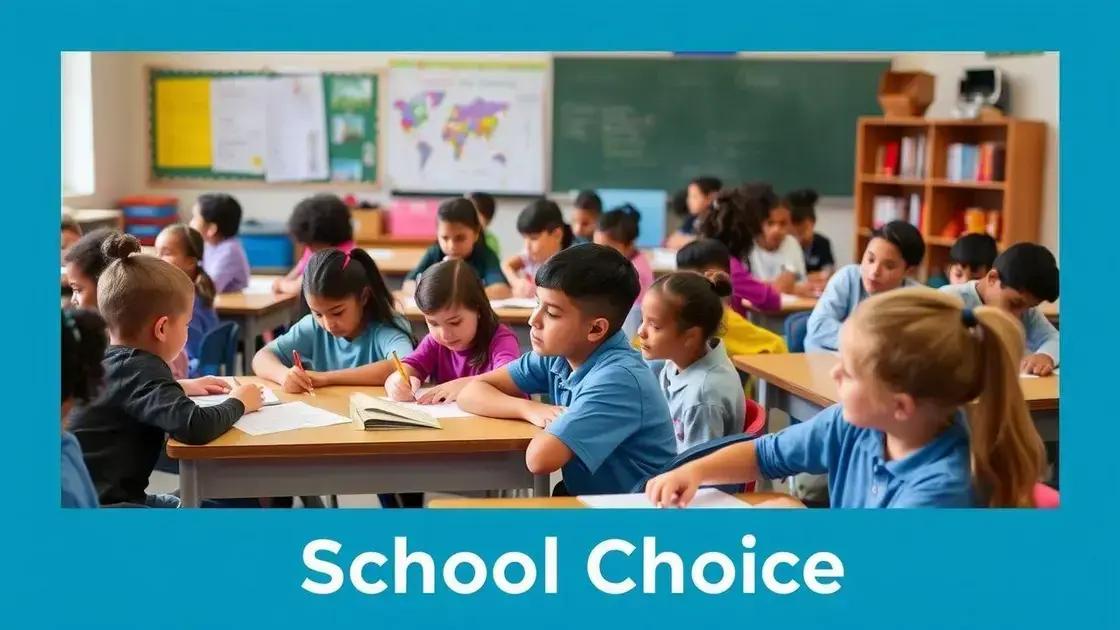Early childhood education trends: what you should know

Anúncios
Parent involvement in education significantly enhances children’s academic success, emotional well-being, and overall engagement in learning through active participation in school activities and support at home.
In today’s world, early childhood education trends are evolving rapidly, and it’s fascinating to see how they influence young learners. Have you noticed changes in educational practices? Let’s explore what these trends mean for our children.
Anúncios
Integration of technology in early learning
Technology plays a crucial role in early childhood education. It not only enhances learning but also prepares children for a digital future. From interactive applications to smart tools, the landscape is changing rapidly.
Benefits of Using Technology
When thoughtfully integrated, technology can provide numerous advantages to young learners. It makes learning engaging and interactive. Children become more involved in their education, which leads to better retention of information.
Anúncios
- Interactive learning: Educational tools can increase engagement.
- Skill development: Children develop essential skills such as critical thinking and problem-solving.
- Accessibility: Technology can help meet diverse learning needs.
- Collaboration: Encourages teamwork through online platforms.
As educators embrace these changes, it’s vital to ensure that technology complements traditional teaching methods. For instance, using tablets or apps that support reading can enhance literacy skills.
Examples of Technology in Early Learning
Many classrooms now include computers and tablets as routine learning tools. These resources help children explore new concepts in an engaging manner.
Some popular tools include interactive whiteboards, bringing lessons to life with visuals and touch. Games that support math and language foster a love for learning while providing valuable practice. Schools are also using online platforms to communicate with parents, enhancing involvement in their child’s education.
Overall, the integration of technology in early learning is transforming education, making it more adaptable and exciting for children. As we look ahead, it’s essential to strike a balance, ensuring that technology enhances learning rather than replacing interpersonal interactions.
The role of play in education
Play is a vital component of early childhood education. It fosters creativity and encourages exploration. Through play, children learn valuable skills that shape their development.
The Importance of Play
Engaging in play allows children to develop their social, emotional, and cognitive abilities. It’s through these experiences that they make sense of the world around them.
- Social skills: Children learn to cooperate and communicate with peers.
- Problem-solving: Play encourages critical thinking and innovation.
- Emotional regulation: It helps children manage their emotions effectively.
- Physical development: Active play promotes coordination and motor skills.
Play should be incorporated into daily learning. When classrooms encourage open-ended play, children can choose activities that interest them. This autonomy promotes engagement and motivates them to learn.
Types of Play in Education
There are various types of play that benefit children in educational settings. For instance, imaginative play allows kids to explore roles and scenarios, enhancing their creativity.
Active play is equally essential, as it involves physical movement and promotes health. Children engage in running, climbing, and dancing, which is crucial for their physical well-being. Structured play, guided by educators, can introduce new concepts in a fun and engaging way.
Encouraging diverse types of play ensures that all aspects of a child’s development are nurtured. Integrating play in education is not just about fun; it’s a purposeful strategy to build a strong foundation for lifelong learning.
Importance of social-emotional learning

Social-emotional learning (SEL) is crucial in early childhood education. It helps children understand and manage their emotions, build positive relationships, and make responsible decisions. Incorporating SEL into education nurtures not only academic success but also overall well-being.
Benefits of Social-Emotional Learning
Integrating SEL into the classroom has numerous advantages. Children learn to express themselves confidently and interact with peers in a respectful manner. This foundation is essential for healthy relationships.
- Improved emotional regulation: Children can manage their feelings better.
- Enhanced empathy: They learn to understand others’ perspectives.
- Better conflict resolution: Skills to resolve disagreements effectively.
- Increased academic performance: A positive emotional state boosts learning.
SEL can also reduce behavioral issues, allowing for a more focused learning environment. When children feel safe and connected, they are more open to learning. Programs focusing on these skills can create a supportive atmosphere in which children thrive.
Implementing Social-Emotional Learning
Educators can incorporate SEL in various ways. Daily routines can include activities that promote teamwork and cooperation. For example, group projects encourage children to communicate and compromise.
Storytelling is another effective tool. Through stories, children explore emotions and learn how to handle different situations. Role-playing can further enhance their understanding of feelings and responses, making lessons more relatable.
Overall, prioritizing social-emotional learning lays the groundwork for children’s future interactions and success. It’s not just about academic achievement; it’s about raising well-rounded individuals who can navigate the complexities of life.
Diversity and inclusion in early childhood
Diversity and inclusion are essential in early childhood education. They create an environment where every child feels valued and respected. A diverse classroom reflects the world around us and prepares children for future interactions.
Understanding Diversity
Diversity includes differences in culture, language, ability, and family structure. Recognizing these differences helps children develop a broader perspective of the world.
- Cultural awareness: Children learn to appreciate different traditions and values.
- Language diversity: Exposure to multiple languages enriches communication skills.
- Inclusivity: Every child, regardless of ability, should feel included in activities.
- Representation: Diverse materials and resources promote understanding.
Incorporating diverse books and activities allows children to see themselves represented in their learning environment. This representation matters as it fosters self-esteem and acceptance.
Strategies for Inclusion
Creating an inclusive classroom takes intentional planning. Educators can use strategies that support all learners. First, adapting lessons to meet various learning needs ensures every child can participate fully.
Another important approach is to encourage peer interactions. Group activities where children work together promote a sense of community and understanding. Support from teachers and aides is vital in guiding these interactions to ensure they are positive.
Finally, involving families in the education process enriches the experience for children. Schools can host events celebrating different cultures, inviting families to share their stories and traditions.
Overall, embracing diversity and inclusion in early childhood education leads to a richer learning experience. It prepares children to thrive in a diverse society.
Parent involvement in educational success
Parent involvement is essential for educational success. When parents engage in their children’s learning, it creates a strong foundation for academic achievement and personal growth. Children whose parents are involved often exhibit better behavior and higher test scores.
Benefits of Parent Involvement
Active participation from parents leads to numerous benefits for students. It fosters a sense of security and motivation in children, encouraging them to strive for excellence.
- Improved communication: Open dialogue between parents and teachers enhances understanding.
- Increased confidence: Children feel supported and encouraged when their parents participate.
- Better attendance: Involved parents often ensure regular school attendance.
- Stronger relationships: Collaboration between home and school builds trust and respect.
When parents are present at school events, it shows children that education is important. This investment in their learning journey can significantly impact their attitudes toward school.
Ways for Parents to Get Involved
There are many ways parents can get involved in their children’s education. Attending parent-teacher conferences is a great start. These meetings allow parents to discuss their child’s progress and address any concerns.
Volunteering in the classroom or at school events also supports a child’s learning experience. Parents can assist in organizing activities that promote engagement and community. Additionally, helping with homework and projects can reinforce learning at home.
Furthermore, parents can encourage a love for learning by reading together or discussing school topics. This involvement not only helps with academic performance but also strengthens family bonds.
Ultimately, parent involvement is a crucial element that contributes to educational success. By fostering a strong partnership between home and school, both parents and educators can create a positive impact on children’s lives.
FAQ – Parent Involvement in Educational Success
Why is parent involvement important in education?
Parent involvement is crucial as it leads to improved academic performance, better behavior, and a more supportive learning environment for children.
What are some effective ways for parents to get involved?
Parents can get involved by attending school events, volunteering in the classroom, helping with homework, and maintaining open communication with teachers.
How does parent engagement impact children’s emotional well-being?
Active participation by parents leads to greater emotional support for children, helping them feel secure and confident in their learning.
Can parent involvement influence a child’s attitude towards school?
Yes, when parents show interest and support for education, it encourages a positive attitude towards school and fosters a lifelong love for learning.






